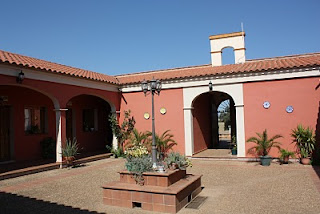Travel (5) cars on the Raia de Portugal. Chapter II The journey never ends. Only travelers end. And they can survive in memory, recollection, narration ... The purpose of a trip is just the beginning of another journey. (José Saramago)
FIRST STOP - Menhir pissing East the Portuguese town of Mead, of Póvoa freguesia and Piss, concelho of Castelo da Vide and Portalegre district, is the more menhir high of the Iberian peninsula about 7 mts. visible high and just over a meter thick.
Reaching him from the Quinta Bela Vista, is just a walk of 10 km, by beautiful oaks and cork oaks and grass so green, you feel like eating it.
remember ... Piss Crossing where we stopped the 5 car without knowing the correct direction, the bumpy road, the old fawn dying under the oak, the walk to the menhir amidst jokes and laughter, circle of potatoes and Conchi rise in an oak.
SECOND STOP - CASTELO DE VIDE
Castelo de Vide, is a town very close to Marvão, which depended for administrative and military time. Rises over the Sierra de San Mamede, while another typical village strength, born of its strategic position along the border, amid a rugged landscape that surrounds a delay pastures.
El Casco Histórico de Castelo de Vide, is a priceless medieval with medieval Jewish quarter and Burgo, huddled among winding streets, held, protected by a large walled perimeter .
Castelo de Vide say that is the Sintra of the Alentejo, and it answers Saramago:
"The trees around Castelo de Vide are not those of Sintra fortunately. Because instead of having here a landscape of imitation, we have a real one, under another sky, involving other urban reality, another way of living. If Castelo de Vide was another Sintra, would not be worth coming so far here. "
remember ...
The Igreja de Santa Maria de la Devesa, in the center of the Plaza de Pedro V and the little Virgin on a monument that looked like a cake, the carousel of the 60 children waiting for, public services clean as a whistle, the antique shop where we lost some nostalgic, full of magnolia flowers, the smell of the steep streets, the view from the other side of the castle, from Extremadura to reach the woman who explained the "Carnival Trapalhão" with a broad smile and cats Jewry.
THIRD STOP - WATERMILLS of ewe (English line) The Aceña of the Borrego is a small English village in the bay near Valencia de Alcántara. A magnificent landscape surrounding it, as always in this area, but the most interesting of this small village is " An Milio Ca ", a restaurant with those who might be called" patriotic "as" An AC Juli "," An Figue ca "or" velai "all the Fronteira.
restaurant is a canonical with a side bar and dining room to the other. The other rites remain, to make you sit at the table a bottle of soda The Antoñita Valencia de Alcántara, the most typical of La Frontera, pitarra another 'national' and Valdefuentes a salad bowl. Then you ask, but always patriotic dishes. In other words: rice with hare hunted in the area, local kid with good fried potato slice giant rabbit from nearby mountains, tortillas free-range eggs from Extremadura. For dessert, serradura top border and the song of 'The lamp' with his hand on his chest. Are there any higher?
remember ...
Laughter, laughter, laughter
the love, affection, affection,
The tortilla and salad,
the poems on the table,
the goat stew and wine Extremadura
desserts potions
ice tray, flying over our heads
talk on the barrel at the door.
FOURTH STOP - MARVAO
centuries, Marvão bears the nickname 'The nest of the eagles'. No wonder: the villa was built more than eight hundred feet above one of the peaks of the Sierra de São Mamede, six miles short of the border with Spain. An impregnable mountain of granite separates the valleys and meadows. To reach it is necessary curves strenuous climb born at her feet. Once up, the sacrifice will be worthwhile. The medieval town of Marvão is white as snow, paved and irregular, tortuous, steep, protected by a thick line of dark walls with corners open bastions, battlements and watchtowers. Walled houses are decorated with wrought iron balconies, fireplaces and picturesque Alentejo Manueline windows, well equipped for cold winter days.
remember ...
Landscape linking Spain and Portugal, vertigo the Clock Tower, the lime light houses, cobblestone streets, lanterns, small bridges connecting the houses, fireplaces, spectacular views, the beautiful Pousada de Santa Maria, at the same height of the clouds, coffee , Portuguese music and the silence of a frozen time, no past and no future.
STOP and FONDA - Cortijo Los Cantos (Albuquerque). (English Raya)
Encinas, rock roses and rosemary, natural reserves for mammals, one of the most idyllic and welcoming of Extremadura, a farmhouse in the middle of the Sierra de San Pedro, with traditional huts for accommodation, or rooms around a central courtyard with names like: Flor de Jara, Dehesa Extremadura, black stork ...
remember ...
The laughter of the way, turns in Albuquerque, the road, at night, to the farmhouse, the thickets on the road, endless curves, as desired arrival, discovery and surprises, endless dinner, scares, Manuel with the phone in his hand running towards me, the conversation before bedtime, the sunrise in the Sierra, the glare of the sun on numb areas, breakfast and joy to continue, knowing that there were still time.



















































